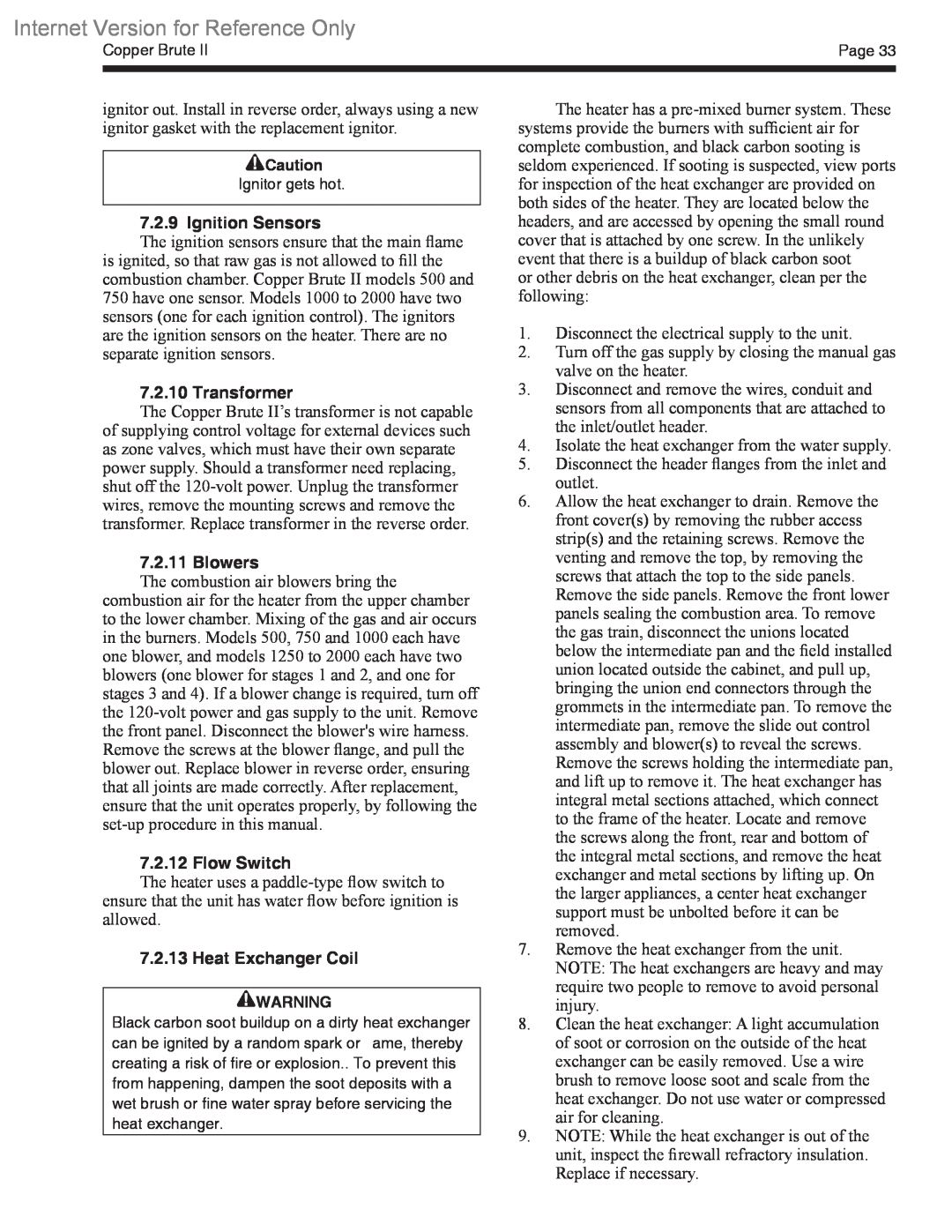
Internet Version for Reference Only
Copper Brute II | Page 33 |
|
|
|
|
ignitor out. Install in reverse order, always using a new ignitor gasket with the replacement ignitor.
![]() Caution
Caution
Ignitor gets hot.
7.2.9 Ignition Sensors
The ignition sensors ensure that the main flame is ignited, so that raw gas is not allowed to fill the combustion chamber. Copper Brute II models 500 and 750 have one sensor. Models 1000 to 2000 have two sensors (one for each ignition control). The ignitors are the ignition sensors on the heater. There are no separate ignition sensors.
7.2.10 Transformer
The Copper Brute II’s transformer is not capable of supplying control voltage for external devices such as zone valves, which must have their own separate power supply. Should a transformer need replacing, shut off the
7.2.11 Blowers
The combustion air blowers bring the combustion air for the heater from the upper chamber to the lower chamber. Mixing of the gas and air occurs in the burners. Models 500, 750 and 1000 each have one blower, and models 1250 to 2000 each have two blowers (one blower for stages 1 and 2, and one for stages 3 and 4). If a blower change is required, turn off the
7.2.12 Flow Switch
The heater uses a
7.2.13 Heat Exchanger Coil
![]() WARNING
WARNING
Black carbon soot buildup on a dirty heat exchanger can be ignited by a random spark or flame, thereby creating a risk of fire or explosion.. To prevent this from happening, dampen the soot deposits with a wet brush or fine water spray before servicing the heat exchanger.
The heater has a
or other debris on the heat exchanger, clean per the following:
1.Disconnect the electrical supply to the unit.
2.Turn off the gas supply by closing the manual gas valve on the heater.
3.Disconnect and remove the wires, conduit and sensors from all components that are attached to the inlet/outlet header.
4.Isolate the heat exchanger from the water supply.
5.Disconnect the header flanges from the inlet and outlet.
6.Allow the heat exchanger to drain. Remove the front cover(s) by removing the rubber access strip(s) and the retaining screws. Remove the venting and remove the top, by removing the screws that attach the top to the side panels. Remove the side panels. Remove the front lower panels sealing the combustion area. To remove the gas train, disconnect the unions located below the intermediate pan and the field installed union located outside the cabinet, and pull up, bringing the union end connectors through the grommets in the intermediate pan. To remove the intermediate pan, remove the slide out control assembly and blower(s) to reveal the screws. Remove the screws holding the intermediate pan, and lift up to remove it. The heat exchanger has integral metal sections attached, which connect to the frame of the heater. Locate and remove the screws along the front, rear and bottom of the integral metal sections, and remove the heat exchanger and metal sections by lifting up. On the larger appliances, a center heat exchanger support must be unbolted before it can be removed.
7.Remove the heat exchanger from the unit. NOTE: The heat exchangers are heavy and may require two people to remove to avoid personal injury.
8.Clean the heat exchanger: A light accumulation of soot or corrosion on the outside of the heat exchanger can be easily removed. Use a wire brush to remove loose soot and scale from the heat exchanger. Do not use water or compressed air for cleaning.
9.NOTE: While the heat exchanger is out of the unit, inspect the firewall refractory insulation. Replace if necessary.
